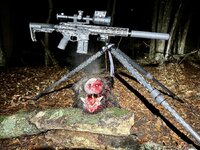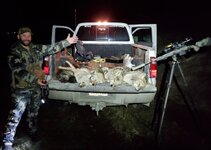Navigation
Install the app
How to install the app on iOS
Follow along with the video below to see how to install our site as a web app on your home screen.
Note: This feature may not be available in some browsers.
More options
Style variation
You are using an out of date browser. It may not display this or other websites correctly.
You should upgrade or use an alternative browser.
You should upgrade or use an alternative browser.
Thermal/NV predator kills
- Thread starter Split toe
- Start date
SilentCedars
WKR
Badass nice cutters8.6 blackout, Thermion HD, and cutters…View attachment 643976
Thanks for that info.I've been a dealer for both Night Vision and Thermals for many years. I've also used both for hunting. In my opinion ... Thermal Optics will get you much better clarity and distance.
Here is a break down of Pro's and Con's:
Pro's to Thermal:
Con's to Thermal:
- Prices continue to go down while quality and sensitivity of sensors is going up (handheld models starting at $500)
- The clear images allow you to see exactly what you are looking at
- The distance at which you can identify and determine a target is fantastic
- You will see animals in areas that you never could before (dense brush, wooded areas, high grass, etc.)
- Weapon Mounted Thermal Scopes have very good reticles allowing you to engage accurately
- Size and weight of Thermals are getting smaller and lighter
- You can use in day or night environment
- User interface and zeroing is very easy and user friendly
- Most have wi-fi capability and recording capabilities as well
- Thermals see differences in temperature (hot and cold) it doesn't matter what kind of light there is (zero moon light to bright areas)
Pro's to Night Vision:
- Prices are still higher then most night vision scopes (weapon mounted thermal sight average $2500-$3500 starting)
- If you have a weapon mounted system you will have to scan the area with your weapon up (can get tiring unless you are using a tri-pod or aiming sticks)
- Cheaper thermals do not see as far or as clear
- Many average consumers don't understand the specifications to look for in thermals and therefore choose the wrong optic for their application or spend more then necessary.
- They can not be integrated in with an IR aiming laser (used with night vision devices)
- Helmet or head mounted thermals are still very expensive (there are some available...but prices can be $6K-$10K
- Technology keeps getting better and cheaper for night vision (quality NV weapon sight - starting $1500ish)
- Digital night vision can see longer distances and has more clarity
- user interface and zeroing of weapon mounted sights is easier and more user friendly
- Helmet mounted capability as well as weapon mounted with a single tube Night Vision Device (PVS-14)
- IR Aiming lasers visible only through night vision device can be weapon mounted and zeroed making target acquisition and hunting predators on the run much easier.
- Helmet mounted Night Vision Device allows user to scan the area without needing to raise ...and hold weapon up
Con's to Night Vision:
Hope all this helps....Feel free to reach out if you have additional questions or need recommendations. I have a passion for this type of stuff and for helping others getting what is the right set up for them and not breaking the bank.
- distance and clarity are still lacking vs. thermals
- Night Vision is reliant on ambient light ....or an IR Illuminator (IR Flashlight to light up the area you want to see (which is an additional expense)
- Night vision typically you are seeing a target based on color, contrast, and movement (Which means you can easily miss seeing an animal until it is moving)
- If you are using a helmet mount night vision you will want to get some type of IR aiming laser (possibly one integrated with an IR Illuminator) which is an additional expense.
- If you are using a night vision weapon mounted scope you will need to scan the area with your weapon up (gets tiring unless you are using a tri-pod or aiming sticks)
- There are so many different models out now that some average consumers have a hard time knowing what to get and sometimes will choose the wrong optic for the application or spend more money then necessary
-Will
I'm still looking and deciding on thermal vs. NV.
That helps a lot.
Midwest Caribou
FNG
Here is my Illinois bobcat after waiting 6 years for a tag
How far was that.Here is my Illinois bobcat after waiting 6 years for a tag
Midwest Caribou
FNG
30 is yards I think. No more than 50. Came in on pup distress.How far was that.
weekender7
WKR
1Shot1Bull
FNG
weekender7
WKR
weekender7
WKR
Big Flounder
FNG
Some great stuff in this thread! Thanks to all who have posted. Keep 'em coming!
weekender7
WKR
Similar threads
- Replies
- 2
- Views
- 221
- Replies
- 30
- Views
- 1K
- Replies
- 6
- Views
- 879
- Replies
- 2
- Views
- 123
Featured Video
Latest Articles
- TT#64 Josh Boyd Elk Hunting Strategies for Every Season
- Aaron Davidson of Gunwerks
- TT#63 Dirk Durham’s Art of Elk Calling
- BIG Buck Stories with the Dirty Giants Podcast
- TT#62 Brian Barney Hunting Bulls without Calling
- Hoyt Alpha AX-2 SD Review
- Kuiu Kenai vs Outdoor Vitals Vario Hooded Jacket Review
- Hoyt RX-9 Ultra Review
- Hunting Vampire Bucks & Building an Optics Kit
- Darton Sequel ST2 35 Review




